Dive Brief:
- The LinkUS Mobility Corridors Initiative has kicked off in the Columbus, OH region as an umbrella program for public and private entities to collaborate on mobility efforts. The initiative — spearheaded by the City of Columbus, the Mid-Ohio Regional Planning Commission (MORPC) and the Central Ohio Transit Authority (COTA) — will focus on improving transportation while promoting economic activity along specific corridors.
- Partners aim to make the region more supportive of all transportation modes, not just motor vehicles or transit. Key goals include developing new mobility options for the region, addressing traffic congestion and expanding access to mobility options in an equitable manner while simultaneously creating jobs and new housing.
- Work on the LinkUS initiative followed the development of other future-looking regional plans, including insight2050 and COTA's NextGen, which lay out strategies for accommodating Columbus' estimated growth of about 1 million people by 2050.
Dive Insight:
Transit-oriented development is becoming more popular as traffic congestion woes increase. It is viewed as a way to get cars off the road by creating walkable, bikable, transit-forward hubs near the areas where people live and work.
LinkUS serves as a unifying program for regional groups working toward these similar community progress goals. Hosting these mobility efforts under one umbrella initiative could reduce redundancy, miscommunication, unnecessary costs and other detrimental outcomes that occur when city projects are carried out in silos.
Cities increasingly are adopting strategies for transit-oriented development. Last year, the Miami-Dade Board of County Commissioners changed zoning regulations to allow greater density along six transit corridors. Meanwhile, California lawmakers have made several attempts in the past few years at passing sweeping statewide legislation to allow greater housing density along cities' transit corridors.
Having everything a person needs within easy access of a non-vehicular mobility option can also cut household costs. Transit-oriented development plans often include strategies or stipulations to ensure a certain percentage of housing in the corridors remains affordable.
"A big part of how we look at these corridors to ensure they're accessible to people who need affordable housing. That land use works hand-in-hand with other uses on the corridors. We have to make sure this is not transportation working in a vacuum," Thea Ewing, transportation and infrastructure development director at the Mid-Ohio Regional Planning Commission (MORPC), told Smart Cities Dive.
LinkUS organizers are working to keep equity at the forefront of the initiative. Increasing access to jobs, schools and other resources through upgraded transportation options is considered a major way to improve the lives of low-income residents. Efforts are underway to focus on communities in most need of assistance and to listen to what those communities say they need.
"We don't want to develop something that seems inaccessible to certain segments of the population," Ewing said.
LinkUS plans to ramp up community engagement and work with community partners to collect input on the corridor transformation projects this summer.












